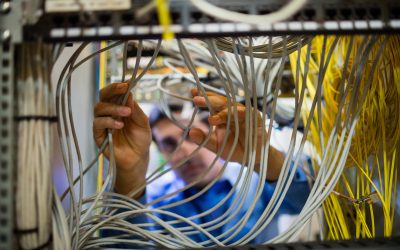Structured Cabling Infrastructure – Enabling Converged Wireless Technologies

Tags: Category 6 | Convergence | Structured Cabling
The converging of wired and wireless technology presents numerous challenges to managers of network infrastructures. No longer do managers only have to worry about voice and data; they must now be well versed in the installation and support of integrated voice, data, video, RF and a variety of building management systems. Industry trends moving toward IP-based integrated networks result in significant demands on IT managers and their network infrastructures.
In anticipation of this, let’s take some time to remember the fundamentals of a structured cabling infrastructure. As you should hopefully guess from its name, it is a cohesive way of organizing a cabling infrastructure and there are basic rules governing this:
- It uses standardized media and layout for both backbone and horizontal cabling.
- It uses standard connection interfaces for the physical connection of equipment.
- It supports equipment and applications of many vendors — not just a single vendor. The cabling system should be independent of the vendor’s equipment, and thus, is more flexible. This is also known as “Open Architecture.”
- It has a consistent and uniform design. It follows a system plan and basic design principles.
- It is designed and installed as a total system. Avoid installing cabling on an as-needed basis.
The benefits of using a structured cabling to support all IP traffic include lower material and labor costs, a single installation force for cabling, a single point of contact for systems integration, reduction in physical space requirements, lower relocation expenses, reduced maintenance and administration costs, and the ability to migrate to new technologies with greater ease, less risk and lower costs.
The ideal structured cabling system is not just the use of a category of cabling product (Category 5e, 6, 6A etc) in the building. In fact, an infrastructure may have a mixture of twisted pair, coax and fiber optic cabling, but also important is the design, installation and ongoing management. The concept is to CABLE ONCE. The extra material cost and labor expense incurred in implementing a true structured cabling system is minimal compared to the higher labor expense involved in upgrading and re-cabling at a later date.
With a true structured cabling infrastructure, the merging of telephones, computers, wireless access points, IoT devices and building management controls onto one centralized IP network is enabled as the technology evolves, as well as improving the building’s green footprint. The structured network infrastructure becomes a ‘fourth utility’ of a building.
The key to this is early planning, long term thinking and avoiding ‘living for today’ investment, which is as applicable to networking as it is in all walks of life.
Want to learn more about wired and wireless infrastructure, consider courses available at the Cabling Science Institute.

Written by James Donovan
You might also enjoy
FO Connector Contamination – A Constant Threat
Fiber optic communication most commonly works in duplex or multifiber transmission by transmitting light to a receiver in one direction on a fiber and receiving transmitted light back to a second receiver on the second fiber. Most engineers can understand that and...
Why Inspect and Clean Fiber Optic Connectors?
Inspecting and cleaning of fiber optic connectors during installation and when making any patching, is essential. Any contamination on a patch cord connector will be transferred through the coupler to the connector it is mated to. Even when testing fibers with a test...
Cleaning MPOs
MPO connectors should always be inspected with a scope before they are used, be that on a patch cord or a bulkhead. If they need to be cleaned, one-click cleaners are keyed to ensure the tip only fits one way onto the connectors and is able to clean both male and...


